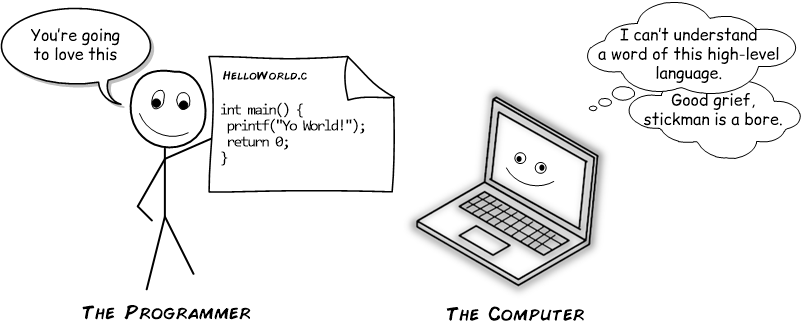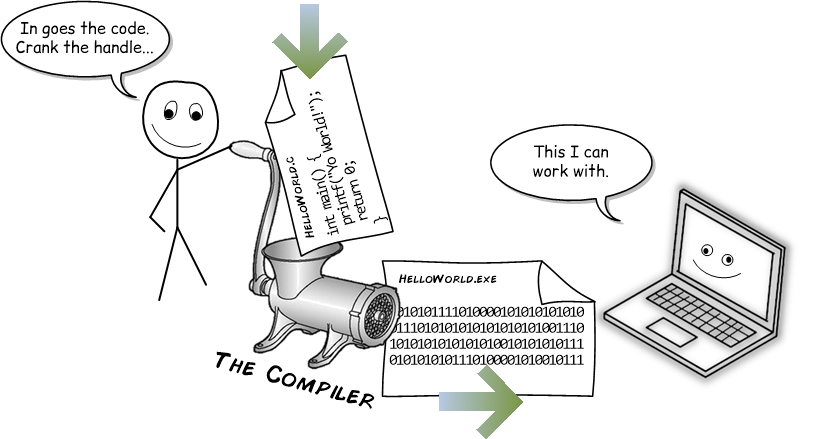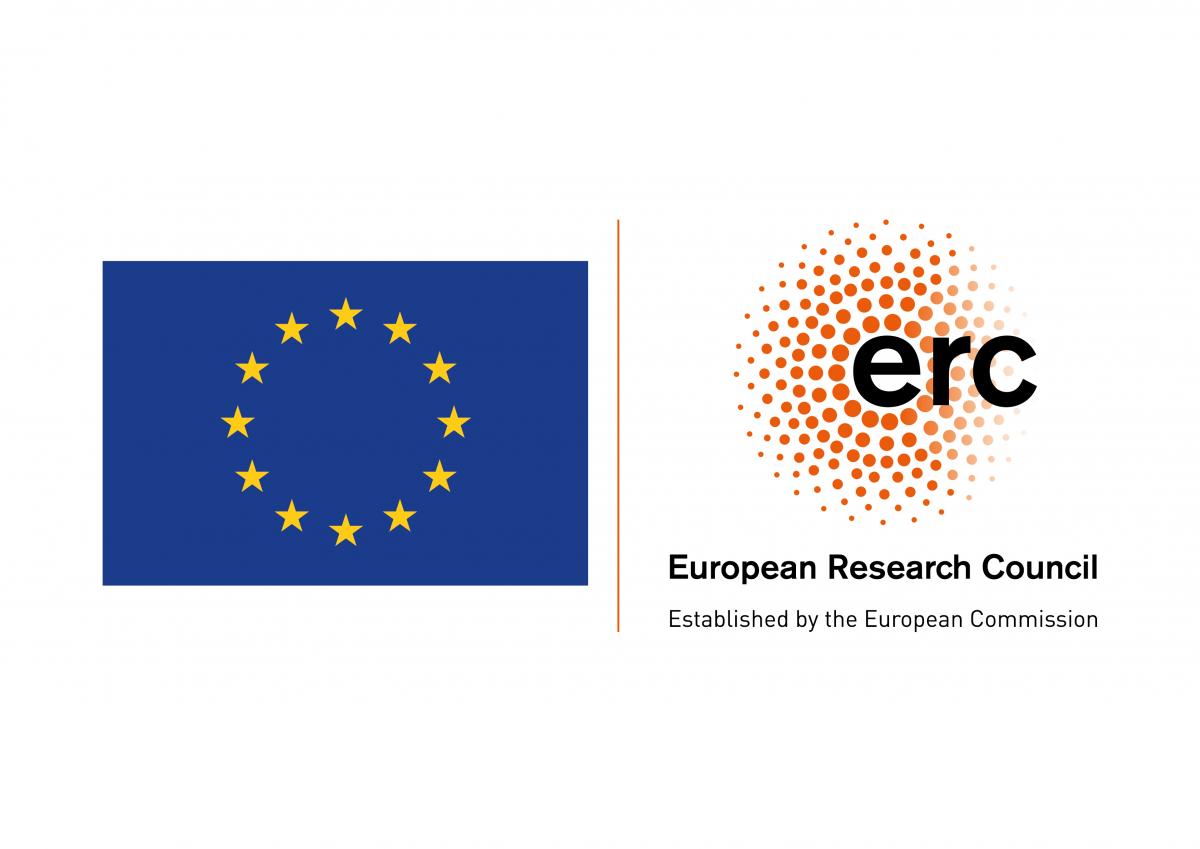Why Julia?
To answer this, we need to review
high-level compiled and interpreted programming languages
High-level programming languages (almost all)

medium.com, Young Coder, The Difference Between Compiled and Interpreted Languages, Sep 14, 2020
Compiled languages (C, C++, Java, ...)  Performance
Performance

medium.com, Young Coder, The Difference Between Compiled and Interpreted Languages, Sep 14, 2020
Interpreted languages (Python, JavaScript, ...)  Productivity
Productivity

medium.com, Young Coder, The Difference Between Compiled and Interpreted Languages, Sep 14, 2020
Trade-off performance and productivity
For computationally-demanding applications (e.g., FEs):
- "Hybrid" software applications:
- E.g.,
pythonfront-end +c++back-end - two-language problem > limited extensibility and prototyping
- E.g.,
- Julia potentially provides better balance
- performance and productivity in a single environment
Main features of Julia
- Optional typing
- Multiple dispatch (generalisation of polymorphism)
foo(bar) = ...
foo(bar::Integer) = ...
foo(bar::Float64) = ...
foo(bar::MyType1,baz::MyType2) = ...
- Multi-paradigm
- Procedural, functional, meta, object-oriented...
Main features of Julia
- Performance through
- type inference (deduce output types from input types)
- generate fast, optimized code
- just-in-time (JIT) or run-time compilation
- user experience as an intepreted one
- type inference (deduce output types from input types)
- The only JIT-compiled language in the petaflop club
- Since 2017; along with C, C++ and Fortran
Main features of Julia
- Time to first plot or compiler latency
- JIT compilation time on first run
julia> @time using Plots
4.860129 seconds (6.87 M allocations: 502.634 MiB, 7.64% gc time, 0.14% compilation time)
julia> @time using Plots
0.000099 seconds (81 allocations: 5.969 KiB)
- Two minor releases per year (+3-5 patch releases per minor)
- Beware of breaking changes and compiler latency regressions
Julia vs Python
- Python has never been so popular (in Feb 2022)
- #1 in TIOBE index (search engine results)
- #1 in IEEE Spectrum index
- #1 in PYPL index
- ...
- Julia way behind (#20-30). Growing, but not emerging
- Often performance not needed or enough with GPU parallelism
Julia vs Python in machine learning



Numbers speak for themselves....
Julia vs Python in machine learning



Numbers speak for themselves.... BUT this is not the whole story!
| TensorFlow | PyTorch | Flux.jl |
|---|---|---|
 |
 |
 |
My case for Julia
- It risks becoming a niche language for scientific computing
- But it could become THE standard in this domain
- The only petascale-capable JIT-compiled language
- Improved balance of productivity and performance
- e.g. in basic research on finite elements
- Further reading: independent benchmarks
- Julia vs C gcc -- similar performance, C is best --
- Julia vs Python 3 -- Julia much faster --
Getting started with Julia
- Download and install
- Differences from Python/C/C++
- The Julia package manager
- Introductory tutorials
- Style and performance tips
- Noteworthy packages
- VS Code as Julia IDE
- The Julia Community
Download and install Julia
Julia comes with a full-featured interactive command-line REPL (read-eval-print loop) built into the julia executable
Documentation
Julia is well-documented
It comprises an excellent manual
Manual / Getting started USE IT!
Fast-track to Julia from Python/C/C++
- Noteworthy differences from Python and C/C++
- Array indexing in Julia is 1-based not 0-based
- Julia arrays are column major (Fortran ordered)
- Julia has no classes (data + methods) and no multiple inheritance
- ...
- Julia Cheat Sheet
- Matlab-Python-Julia Cheat Sheet (outdated)
The Julia package manager, Pkg.jl
- Integrated into the REPL (Pkg documentation)
- Manages reproducible environments, not only packages
- An environment is a record of
- Package dependencies and compatibilities in
Project.toml - Package state (
pkgversion,gitrevision, ...) inManifest.toml
- Package dependencies and compatibilities in
- An environment is a record of
- If a Julia project ( library) contains a manifest, this will install the packages in the same state that is given by that manifest
Set up the working environment
- Work in projects or packages
- Creating packages
- With Pkg.jl
- With PkgTemplates.jl
For software projects
- e.g., set up Github Actions (continuous integration)
- With DrWatson.jl
For scientific projects
- e.g., manage and reproduce parametric simulations
Introductory tutorials
- JuliaTutorials
- Jupyter notebooks (e.g., 00, 01, 06, 10, 10.1 and 09)
- Julia track in Exercism
- Solve coding exercises and get mentored
- General and domain-specific courses
- Introduction to Julia ➔ Videos for JuliaTutorials
- Foundations of Machine Learning
How to develop your code in Julia?
- Follow test-driven development
- Option 1: Combine your editor of choice and the REPL
- REPL-based workflows
Use Revise.jl
Add
Revise.jlin the global (default) environment
- REPL-based workflows
- Option 2: Use VS Code with Julia extension (THE Julia IDE)
- VS Code workflows
- Matlab-ish experience (e.g., workspace browser, debugger...)
How to write your code in Julia?
- Style guide
- Append
!to names of functions that modify their arguments- e.g.,
sortdoes not mutate,sort!mutates
- e.g.,
- Prefer exported methods over direct field access
- data members of a type are not hidden
- Apply naming and argument ordering similar to Julia base
- ...
- Append
How to write your code in Julia?
- Performance tips
- Performance critical code should be inside a function
- Julia's compiler works better on code inside functions
- Avoid global variables
- Write "type-stable" functions (results in faster code)
- Measure performance and memory footprint with
@time
- Performance critical code should be inside a function
- Use BenchmarkTools.jl and ProfileView.jl
More on VS Code as Julia IDE
- Quite powerful
- Built-in debugger
- Native support for Jupyter notebooks (e.g., JuliaTutorials)
- Embedded results (e.g., plots, profiler, databases)
- New features every year (announced in JuliaCon)
- Collaborative sessions
- A "Google Docs" experience with integrated audio and text chat
Julia for data science and image processing
- Scientific machine learning
- FluxML (GitHub)
- Several JuliaCon vids like this one
- SciML (GitHub)
- Julia SciML Symposium at SIAM CSE 2021
- FluxML (GitHub)
- Image processing
- JuliaImages (GitHub)
- DeconvOptim.jl (incipient)
Parallel computing in Julia
- Multi-threading is "Open-MP"-style and built in the core library
- Multi-processing and distributed computing
- With standard module
Distributedor non-standardMPI.jl, ...
- With standard module
- GPU computing
- Julia joins petaflop club petaflops / threads / k cores
- Poisson FE problem up to k cores in GridapDistributed.jl
Other interesting packages
- DataFrames.jl: fast tabular data manipulation
- Pluto.jl: reactive Jupyter notebooks
- Makie.jl: interactive plots
- DrWatson.jl: scientific projects management
Community
- 35 million downloads as of Jan 2022
- Full statistics Jan 2022
- JuliaCon: free and virtual
- 2022 edition in July 27-29
- 2021 edition
- 43,000 unique viewers
- > 300 presentations on YouTube
Gridap.jl in JuliaCon 2021
Getting help
- Julia Discourse
- Go-to place
- Read this before posting
- Stack Exchange and Stack Overflow not so active
- Julia Slack
- Dedicated channels (#gridap, #machine-learning, ...)
- Julia Manual ALWAYS
Announcements
- SciMLCon 2022
- free and virtual on Mar 23 15:00-23:00 CET
- Google Summer Of Code 2022
- Funded and mentored online "interships" in an open source organization
- Applications open April 4 - 19
And that's all! Thank you!

Except where otherwise noted, this work and its contents (texts and illustrations) are licensed under the Attribution 4.0 International (CC BY 4.0).